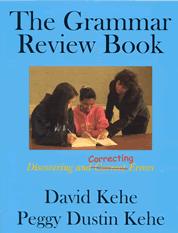This is an easy-to-use book for:
anyone who has learned English by ear
generation 1.5 students
learners with fossilized errors
anyone who needs basic grammar
anyone who needs to write grammatically
This isn't your ordinary grammar book -- you know the kind: A diagram showing how the present perfect works and a few rules to follow. Then various exercises for applying the rule. Few mistakes are made, and you go on to the next unit. But the students continue to mess up the distinction between the present perfect and simple past. Have you used such a book? This book is different. Using students' strengths, it empowers them to become aware of their errors and to self-correct them.
The Kehes developed this book to meet an urgent need that their students encountered as they tried to write. Their students produced writing that had too many errors because they had picked up English mostly through their ears, and not through their eyes (by studying grammar and writing out grammar exercises). Many of them were quite fluent in English. Their pronunciation was native or nearly so. But they wrote sentences without a subject, they used prepositional phrases as the subject of a sentence, and their use of verb tenses was sloppy. So the Kehes decided to help the students develop an awareness of grammatical structure and terminology by using their students' ability to "pick things up" and develop their own inner criteria for correctness in order to be effective self-correctors.
The result: a different kind of error correction approach. Each unit focuses on a problem, for example: "We should to eat vegetables." Then the students work through a carefully sequenced series of exercises that leads them to recognizing errors and discovering how to fix them.
A Sampler of the Problems
Is beautiful today... She the best worker... She doesn't likes skiing... He felt ill he went to the doctor... Is easy to do math... I like there house... She has lived there last year... I finished read that book... Every student need a book... At the beach is beautiful... She able to write a report... The woman lives near my house is beautiful.
This student-centered approach lets the students learn individually, in pairs, and in groups. It frees the teacher to work one-on-one, observing, helping, encouraging, and only occasionally explaining.
Books by David Kehe & Peggy Dustin Kehe
Basic Conversation Strategies
Conversation Strategies
Discussion Strategies
Writing Strategies One
Writing Strategies Two
Write after Input
The Grammar Review Book





